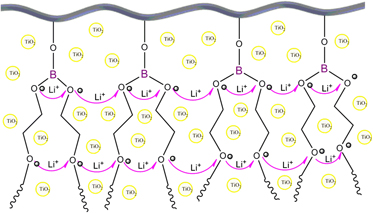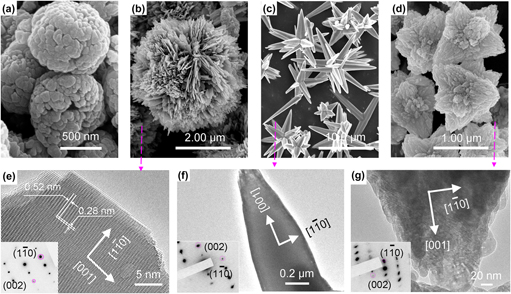Cover: FIG. 1(c). SEM image of polymorphous ZnO samples produced at en/Zn2+ molar ratio of 1.0. [G. Tong, F. Du, C. Tong, Y. Liu, and J. Tao: Selective Synthesis and Shape-Dependent Microwave Electromagnetic Properties of Polymorphous ZnO Complex Architectures. p. 649].
Articles
Synthesis of nanoparticles, nanorods, and mesoporous SnO2 as anode materials for lithium-ion batteries
-
- Published online by Cambridge University Press:
- 04 March 2014, pp. 609-616
-
- Article
- Export citation
In situ chemical synthesis of SnO2/reduced graphene oxide nanocomposites as anode materials for lithium-ion batteries
-
- Published online by Cambridge University Press:
- 11 March 2014, pp. 617-624
-
- Article
- Export citation
Nanocomposite polymer electrolytes comprising PVA-graft-PEGME/TiO2 for Li-ion batteries
-
- Published online by Cambridge University Press:
- 11 March 2014, pp. 625-632
-
- Article
- Export citation
Highly fluorescent CdTe nanocrystals: Synthesis, characterization, property, mechanism, and application as a sensor for biomolecule analysis
-
- Published online by Cambridge University Press:
- 04 March 2014, pp. 633-640
-
- Article
- Export citation
Enhanced photocatalytic activities on Bi2O2CO3/ZnWO4 nanocomposites
-
- Published online by Cambridge University Press:
- 27 February 2014, pp. 641-648
-
- Article
- Export citation
Selective synthesis and shape-dependent microwave electromagnetic properties of polymorphous ZnO complex architectures
-
- Published online by Cambridge University Press:
- 04 March 2014, pp. 649-656
-
- Article
- Export citation
Multiferroic CoFe2O4–BiFeO3 core–shell nanofibers and their nanoscale magnetoelectric coupling
-
- Published online by Cambridge University Press:
- 04 March 2014, pp. 657-664
-
- Article
- Export citation
Toughening polymer adhesives using nanosized elastomeric particles
-
- Published online by Cambridge University Press:
- 11 March 2014, pp. 665-674
-
- Article
- Export citation
Lanthanide (Eu3+, Tb3+) functionalized SBA-15 through modified hexafluoroacetylacetone linkage: Covalently bonding construction, physical characterization, and luminescent properties
-
- Published online by Cambridge University Press:
- 04 March 2014, pp. 675-683
-
- Article
- Export citation
Microstructural evolution and bonding mechanisms of the brazed Ti/ZrO2 joint using an Ag68.8Cu26.7Ti4.5 interlayer at 900 °C
-
- Published online by Cambridge University Press:
- 28 February 2014, pp. 684-694
-
- Article
- Export citation
On acquiring true stress–strain curves for sheet specimens using tensile test and FE analysis based on a local necking criterion
-
- Published online by Cambridge University Press:
- 04 March 2014, pp. 695-707
-
- Article
- Export citation
Synthesis of high strength aluminum alloys in the Al–Ni–La system
-
- Published online by Cambridge University Press:
- 11 March 2014, pp. 708-717
-
- Article
- Export citation
Incipient straining in severe plastic deformation methods
-
- Published online by Cambridge University Press:
- 04 March 2014, pp. 718-728
-
- Article
- Export citation
Corrigendum
Adhesion, micro- strain and corrosion behavior of ZrN coated AZ91 alloy as a function of temperature.– CORRIGENDUM
-
- Published online by Cambridge University Press:
- 13 February 2014, p. 729
-
- Article
-
- You have access
- HTML
- Export citation
Front Cover (OFC, IFC) and matter
JMR volume 29 issue 5 Cover and Front matter
-
- Published online by Cambridge University Press:
- 11 March 2014, pp. f1-f4
-
- Article
-
- You have access
- Export citation
Back Cover (OBC, IBC) and matter
JMR volume 29 issue 5 Cover and Back matter
-
- Published online by Cambridge University Press:
- 11 March 2014, pp. b1-b3
-
- Article
-
- You have access
- Export citation


















